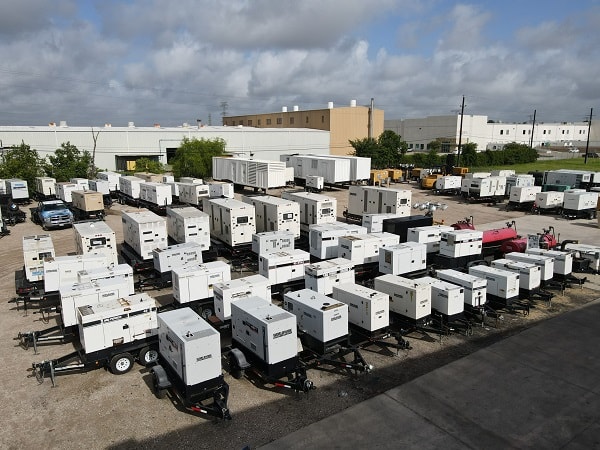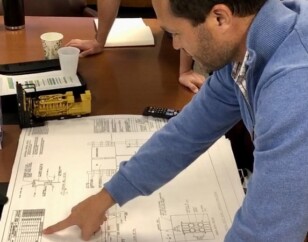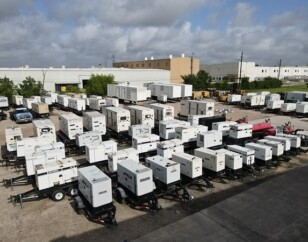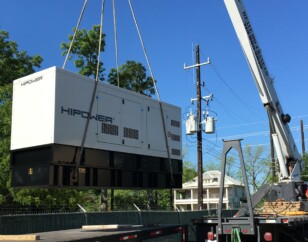Generator Installation in Commercial Buildings
WPP provides backup and emergency generator sales and can deliver turnkey custom solutions and installations.
So you’ve decided to install a standby generator in your office building. Good thinking; losing power can mean unsafe working conditions, loss of electronic data, and significant financial damages. Permanently installed commercial standby generators can keep critical systems up and running through outages, from data centers to elevators, fire alarms, and more.
Of course, the first thing business owners and commercial landlords want to know is, what will a standby generator cost? Unfortunately, that question is impossible to answer with a blanket figure because no two buildings are exactly alike. When installing a standby generator, many different factors including the building’s age, location, uses, and layout will come into play. But we can help you ballpark the costs by explaining how each factor will affect the installation process and your enjoyment of the generator over its lifetime.
WPP Carries One of the Largest Generator Inventories in the USA
The quest for reliable backup or prime power generation in a commercial building begins with the right generator for the job.
At WPP, we carry and ship worldwide a huge number of premium-quality diesel and natural gas generators, which are the most popular option for commercial installations.
But no matter what you’re looking for–new or used, 20 kW or 2.5 MW, Caterpillar of Cummins –you’ll have the best chance of finding it in our inventory, with the friendly customer service and technical expertise to go with it.
Find the Right Generator for Your Building


Placing a Generator: Commercial Building Considerations
The fundamental consideration in determining where to install your standby generator is indoors versus outdoors. Once you make that choice, your options should be significantly narrowed down. But to decide, you’ll need to answer questions such as:
- What is your local climate like? If flood-prone, you’ll want to avoid the basement. If extremely windy, debris such as grass or leaves clogging the vents and overheating the unit can be a concern. Will you be able to access the unit during extreme weather, if necessary?
- What is the local ordinance on sound? This may affect how closely you can place the generator to your property line and could impact what size generator you can use, as larger typically means louder, although newer generators have made significant advances in sound output.
- Where is your building’s electrical room? Ideally, your generator should be installed as close as possible to minimize the conduit run. The automatic transfer switch (ATS) for the generator is often installed in the control room, as well.
- Do you have the space inside? You need enough room for the generator, which could measure anywhere from 10 to 25 feet long, with three feet of clearance on all sides. This is the baseline laid out by the National Fire Protection Association’s (NFPA) National Electric Code, which is not federal law but is very likely to have been adopted in your municipality. Even if you have the physical space, consider whether there is sufficient distance between the sound of a running generator and wherever your day-to-day operations will be conducted.
- How old is your building? Given their large sizes, standby commercial generators are much easier to install in new construction where the contractors can basically build around them. Retrofitting is obviously going to be more difficult, especially in very old buildings. You’ll need to be able to provide the generator with adequate ventilation and exhaust pathways, and a utility hookup if you opt for a generator that runs on natural gas. If you go with a diesel (the most common fuel source for standby generators) or propane generator with extra tanks, you’ll need to incorporate the NFPA’s codes for safely storing and running fuel lines.
How to Size a Standby Generator
In addition to the particulars of your building, how you use the building is an important determinant of what size generator(s) you need. If you need to power the entire building, you’ll need a larger generator than if you only need to power “mission critical” loads. If you need enough backup power for several days at a time, you’ll likely need backup fuel storage tanks.
Commercial buildings engaged in life-and-death services, such as hospitals, have special requirements for downtime and run-time. There may also be specific requirements for backup power put in place by your city or state government. But the average business or apartment building owner typically needs to power only common areas and/or areas vital to their operations, and for only a few hours per year.
According to the U.S. Energy Information Administration, American electricity customers averaged 5.8 hours of power outages in 2018. You probably already know if you live in an area that’s prone to shorter or longer outages than that, so factor that into your tank size calculations. Going by the average outage length, a 12-hour tank (measured by the ability to power the generator at 100%) would be plenty large enough, provided it meets your peak demand power needs.
There are several ways to calculate your power needs. If you know the total load amount of all your operations, you can use our online power calculator. Another way is to review your utility company statements of the prior year and determine your peak demand, then add 25% as a reserve.
If yours is a small- or medium-sized business, you likely need a generator capable of outputting between 10kW and 20kW, for a cost of between $3,000 and $10,000. For large or industrial businesses, you may need up to 500kW or 1,000kW or more, which run tens or hundreds of thousands of dollars. The typical range of prices is $300-$450 per kW.
Use our generator sizing guide to correctly determine your power requirements.
Installation Costs
Costs can vary dramatically but the cost of a generator plus installation by a certified installer will usually begin around $3,000 for the smallest businesses, while a 100kW generator in Houston, for example, runs $125,000.
Choosing a Generator Installer
As you’ve probably deduced by now, installing standby generators for businesses is a complicated undertaking. That’s why it’s important to choose a reliable installer with a proven track record, not only of installing standby generators but generators of your chosen type and configuration. There can be small differences among manufacturers, and as we’ve seen, huge differences from one building to the next.
At a minimum, you’ll need a licensed electrician for your installation, and possibly a plumber if you need a gas line for a natural gas generator. Having a certified installer is crucial for more than just peace of mind–some generator manufacturers won’t honor their warranty unless the unit was installed by a professional.
Commercial Installation Is Part of WPP’s Custom Power Solutions
Some generator retailers also offer installation services, and WPP is proud to be an experienced provider of both in the Texas Gulf Coast region.
When you let us help you with both the purchase and installation of a commercial generator, we can guide you on the sizing, the type of generator, and the system design that would be best for you.



We can also help you secure the necessary air quality permits for the generator, which vary by state and municipality, and ensure that the layout is up to local fire and safety codes. We’ll also handle any necessary subcontractors such as plumbers or electricians or work with your chosen subcontractors.
We can also get you set up with other generator options and add-ons, including:
- A UPS (uninterrupted power supply) battery system for equipment that can’t tolerate even a few seconds of power loss;
- Dual-fuel systems that run on both natural gas and propane, for example;
- Integrating solar panels with the generator; and
- Wireless remote monitoring and control systems.
These are just a few of the value-added services we provide as part of our mission to deliver turnkey power solutions.











